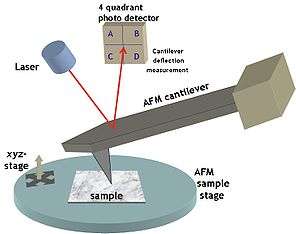Spin polarized scanning tunneling microscopy
Spin-polarized scanning tunneling microscopy (SP-STM) is a specialized application of scanning tunneling microscopy (STM) that can provide detailed information of magnetic phenomena on the single-atom scale additional to the atomic topography gained with STM. SP-STM opened a novel approach to static and dynamic magnetic processes as precise investigations of domain walls in ferromagnetic and antiferromagnetic systems, as well as thermal and current-induced switching of nanomagnetic particles.
Method of operation
An extremely sharp tip coated with a thin layer of magnetic material is moved systematically over a sample. A voltage is applied between the tip and the sample allowing electrons to tunnel between the two, resulting in a current. In the absence of magnetic phenomena, the strength of this current is indicative for local electronic properties.
If the tip is magnetized, electrons with spins matching the tip's magnetization will have a higher chance of tunneling. This is essentially the effect of tunnel magnetoresistance and the tip/surface essentially acts as a spin valve.
Since a scan using only a magnetized tip cannot distinguish between current changes due to magnetization or space separation, multi-domain structures and/or topographical information from another source (frequently conventional STM) must be utilized. This makes possible magnetic imaging down to the atomic scale, for example, in antiferromagnetic system. Topographical and magnetic information can be simultaneously obtained if the tip´s magnetization is modulated at a high frequency (20–30 kHz) using a small coil wound around the tip. The tip´s magnetization thus flips too fast for the STM feedback loop to respond to and topographical information is obtained intact. The high frequency signal is separated using a lock-in amplifier and this signal provides the magnetic information about the surface.[1]
Nowadays, antiferromagnetic tips are in use since ferromagnetic tips induce magnetization reversal in the systems to be studied due to stray fields. In STM tunneling electrons come from the very same atom most close to the surface. Therefore, with the magnetization of this atom well defined, the tunneling current remains polarized for antiferromagnetic tips but without stray field.
Alternate method
Another way to obtain the magnetization distribution is to have the tip provide a strong stream of spin polarized electrons. One method to achieve this is to shine polarization laser light onto a GaAs tip, which produces spin polarized electrons due to spin-orbit coupling. The tip is then scanned along the sample much like conventional STM. One limitation of this method is that the most effective source of spin polarized electrons is obtained by having the incident laser light shine directly opposite of the tip, i.e. through the sample itself. This restricts the method to measuring thin samples.
See also
- Scanning tunneling microscopy
- Microscopy
- Scanning probe microscopy
- spin valve
- tunnel magnetoresistance
References
- ↑ Wiesendanger, R (2009). "Spin mapping at the nanoscale and atomic scale". Reviews of Modern Physics. 81: 1495. Bibcode:2009RvMP...81.1495W. doi:10.1103/RevModPhys.81.1495.
External links
- A brief overview of STM
- Bode, M (2003). "Spin-polarized scanning tunnelling microscopy". Reports on Progress in Physics. 66: 523. Bibcode:2003RPPh...66..523B. doi:10.1088/0034-4885/66/4/203.
